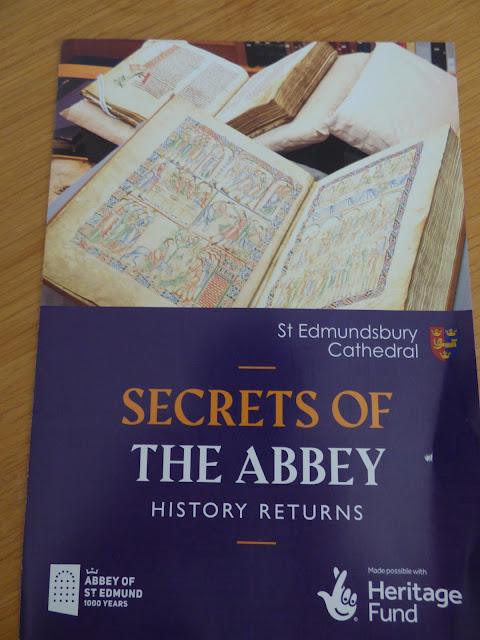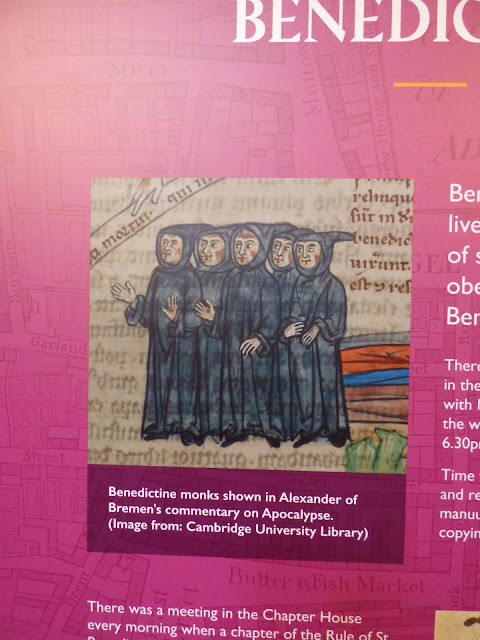....................... and then there are VERY old books. The ones I went to look at on Monday morning fall into that latter category. My cousin and her husband had just been to see them last week when they called in for a cuppa on their way home or I might not have heard about them.
The books were in a special exhibition at the Cathedral in Bury St Edmunds .............................
Because the books were on display in the small Treasury room visiting was by booked but free tickets. So I booked a free ticket online and went to have a look.
Hope you can read the leaflet below which explains that only 270 of the 3,000 books in the abbey survived the dissolution of the monasteries and 154 of those are in the Cambridge Universities libraries. Pembroke College has loaned seven to celebrate the 1000 years of the Abbey (it was actually in 2020 but you know what happened then).
No photos allowed of the illuminated manuscripts but they were very special . There was a screen showing a little of what they look like.
I loved the Illuminated Letters that start each chapter.
Apologies for the poor photos of some of the boards that explain about the abbey and the Benedictine monks
Here is a link to look at the manuscripts in the collection at Pembroke College https://cudl.lib.cam.ac.uk/collections/pembroke/1 copied from the handout below which also mentions a new book ...... Catalogue of the Medieval Manuscripts of Pembroke College Cambridge ....available for £95!
Below explains the colours used in the manuscripts
Briefly this is how the Abbey came to be here
Edmund, King of East Anglia, was killed by The Danes on 20 November 869, after refusing to give up his Christian faith. He was tied to a tree and shot full of arrows before being beheaded.
In 903 the remains of Saint Edmund, the original the Patron Saint of England, were moved to the Anglo-Saxon settlement of Beodericsworth (later known as Bury St Edmunds) where the site had already been in religious use for nearly three centuries.
St Edmund’s body was moved to London in 1010 for safe keeping when The Danes were again marauding through East Anglia but three years later his body was returned to Bedricesworth.
In 1020, King Canute had a stone church built for Edmund's body and the first abbots arrived. This was the beginning of the Abbey of St Edmund and it became a site of great pilgrimage as people from all over Europe came to visit St Edmund’s shrine.
I wrote more about the Abbey when I visited back in 2018 HERE
or the website about the Abbey is HERE
I took a few photos of the Cathedral too - for tomorrow's post











That looks like a fabulous exhibition. Nowadays we can type something on the computer and print it off in minutes (with automatic spellchecker to correct mistakes) Back then copying out God's word was a labour of love, taking months and months - with no mechanical assistance, not even Tipp-ex correction fluid, if you went wrong! This looks well worth a visit.
ReplyDeleteAs you say it would have taken months, I guess that's why they did the doodles and coloured bits when resting from copying
DeleteWonderful that these things have survived.
ReplyDeleteLess wonderful: Google says I don’t have permission to comment on your blog on my PC! I’ve done this on my iPad but what a faff. I may have to give up.
Lucky that they were sent to Cambridge for safe keeping . They have a Bury Bible that they won't lend back as it's so special.
DeleteA Mystery about google
It's good to that so many of these important and beautiful manuscripts and books are now digitised so that people can see and study them without damaging them. (Although nothing can beat seeing the real things.)
ReplyDeleteThe Luttrell Psalter is another good one to see, if you haven't seen it already. You can see it here: http://www.bl.uk/turning-the-pages/?id=a0f935d0-a678-11db-83e4-0050c2490048&type=book
Best wishes
Ellie
Thank you for the link
DeleteWhat a great exhibition for you to visit! Are you able to visit the actual St Edmundsbury library at all? I find the atmosphere in an in situ library is incredible, as if all the energies of monks and clergy learning is present. Inspiring places.
ReplyDeleteI looked up about the library and found out about the tours - something to do another day I think
DeleteLooks lovely Sue - glad you enjoyed it.
ReplyDeleteI do enjoy finding about about things I didn't know about.
DeleteHow very special, thanks for sharing.
ReplyDeleteIt was good to find out about something different
DeleteVisiting this exhibition sounds outstanding. Preservation of the ancient writings is outstanding and learning more about the collection must have been enjoyable. I find the Benedictine Monks and their monastic order quite laudable. Today, the world could benefit from some order.
ReplyDeleteIt was so interesting to visit
DeleteWhat a fascinating exhibition. I have always found ancient lettering so interesting, the personality of the monks somehow comes through.
ReplyDeleteOld books are precious and priceless. Fascinating.
ReplyDeleteWhat a wonderful exhibit. I also love they way the monks started each chapter with colour.
ReplyDeleteGod bless.